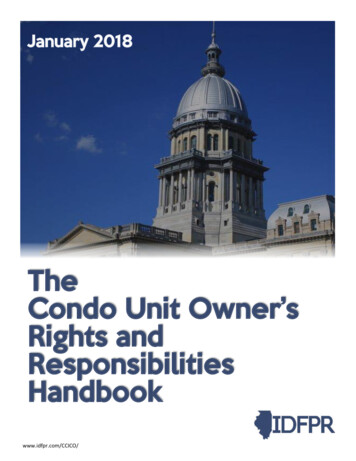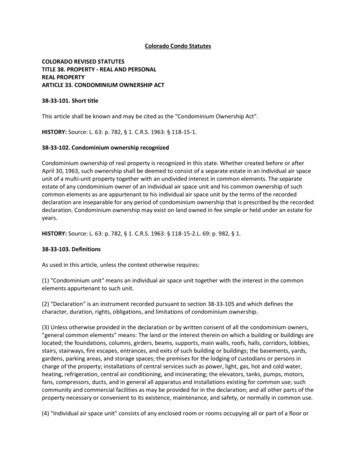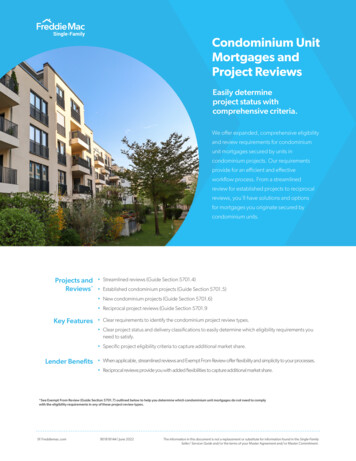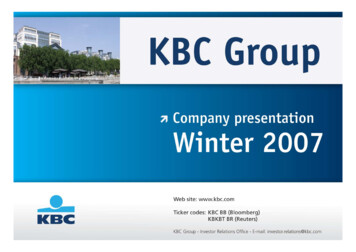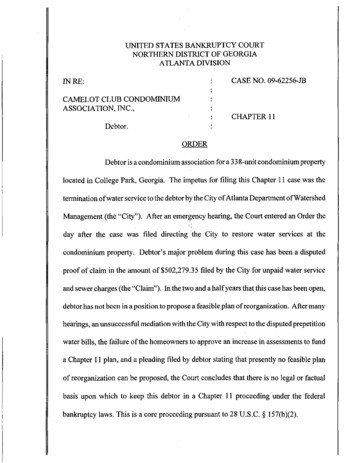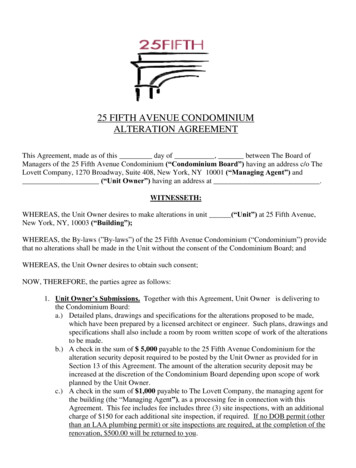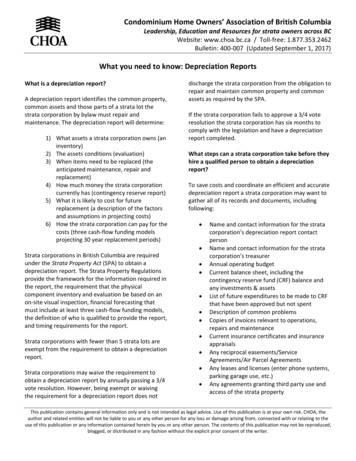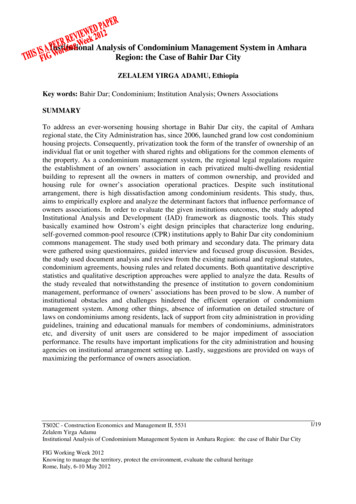
Transcription
Institutional Analysis of Condominium Management System in AmharaRegion: the Case of Bahir Dar CityZELALEM YIRGA ADAMU, EthiopiaKey words: Bahir Dar; Condominium; Institution Analysis; Owners AssociationsSUMMARYTo address an ever-worsening housing shortage in Bahir Dar city, the capital of Amhararegional state, the City Administration has, since 2006, launched grand low cost condominiumhousing projects. Consequently, privatization took the form of the transfer of ownership of anindividual flat or unit together with shared rights and obligations for the common elements ofthe property. As a condominium management system, the regional legal regulations requirethe establishment of an owners’ association in each privatized multi-dwelling residentialbuilding to represent all the owners in matters of common ownership, and provided andhousing rule for owner’s association operational practices. Despite such institutionalarrangement, there is high dissatisfaction among condominium residents. This study, thus,aims to empirically explore and analyze the determinant factors that influence performance ofowners associations. In order to evaluate the given institutions outcomes, the study adoptedInstitutional Analysis and Development (IAD) framework as diagnostic tools. This studybasically examined how Ostrom’s eight design principles that characterize long enduring,self-governed common-pool resource (CPR) institutions apply to Bahir Dar city condominiumcommons management. The study used both primary and secondary data. The primary datawere gathered using questionnaires, guided interview and focused group discussion. Besides,the study used document analysis and review from the existing national and regional statutes,condominium agreements, housing rules and related documents. Both quantitative descriptivestatistics and qualitative description approaches were applied to analyze the data. Results ofthe study revealed that notwithstanding the presence of institution to govern condominiummanagement, performance of owners’ associations has been proved to be slow. A number ofinstitutional obstacles and challenges hindered the efficient operation of condominiummanagement system. Among other things, absence of information on detailed structure oflaws on condominiums among residents, lack of support from city administration in providingguidelines, training and educational manuals for members of condominiums, administratorsetc, and diversity of unit users are considered to be major impediment of associationperformance. The results have important implications for the city administration and housingagencies on institutional arrangement setting up. Lastly, suggestions are provided on ways ofmaximizing the performance of owners association.TS02C - Construction Economics and Management II, 5531Zelalem Yirga AdamuInstitutional Analysis of Condominium Management System in Amhara Region: the case of Bahir Dar CityFIG Working Week 2012Knowing to manage the territory, protect the environment, evaluate the cultural heritageRome, Italy, 6-10 May 20121/19
Institutional Analysis of Condominium Management System in AmharaRegion: in the case of Bahir Dar CityZELALEM YIRGA ADAMU1. INTRODUCTION AND BACKGROUNDHousing is one of the basic necessities for human beings. For long time, however, it remains acritical problem which millions of poor people of developing counties lack, Ethiopia being noexception (Bihon, 2007). Like most urban centres of the developing countries, Ethiopian citiesand towns are presently facing a plethora of problems of acute and ever worsening housingshortage (Solomon & McLeod, 2004). Ethiopia’s persistent urban poverty has made urbanland and housing policy the subjects of ongoing debate. With the intention of reducinghousing problems, the government recently provides various incentives including allocationof land without charge and subsidization of building materials. Nevertheless, these incentivesultimately satisfied only a small portion of housing demands. Gradually, it is deemednecessary to allocate urban land to a high rise or a row of houses condominium buildingwhich assumed to improve the urban land use and supply of housing through making greatnumber of people benefit and commonly hold a small size of urban land (FDRE, 2003,Proclamation No. 370/2003).In order to pursue this new direction, utilisation the role of housing development in urbandevelopment, the government urban strategy involves an approach that launches a nationalIntegrated Housing Development Programme (IHDP). This program targets only middle andlower income households. For its practicality, the state transferred the overall responsibilityfor the housing sectors at regional level to city administration or municipalities (Ministry ofWorks and Urban Development, 2007). Amhara region is one of those regions in Ethiopia thathad started exercising its mandate to address an ever-worsening housing shortage in its majorcities and towns. In terms of housing, regional city administration and housing agency havebeen taking measures to deliver housing to their residents by launching low costcondominium housing projects, but the strategies were unclear and the achievements are toosmall in comparison with the magnitude of the problem.Bahir Dar city, the capital of Amhara regional state, is one of the urban areas of the regionwhere the implementation of IHDP started, since 2006. As a result, the large-scale, high-riseand mixed-use condominiums have become the main usage pattern of buildings in Bahir Darcity with high population density. Yet, condominium management in the city remains one ofthe areas where significant improvement in terms of governance is required. Despite anincreased interest in condominium houses management, few empirical studies have devoted toexamining quality and condition of the currently supplied residential condominiums housesthan its management (Haregewoin, 2007; Sema, 2010). However, a question should be asked:is it enough and valid to evaluate the condition and quality of condominium only with respectto the status of condominium in quality and conditions without understanding the governingrules? This is because the methods adopted to evaluate the status of quality and conditionsTS02C - Construction Economics and Management II, 5531Zelalem Yirga AdamuInstitutional Analysis of Condominium Management System in Amhara Region: the case of Bahir Dar CityFIG Working Week 2012Knowing to manage the territory, protect the environment, evaluate the cultural heritageRome, Italy, 6-10 May 20122/19
have lacked the considerations of institutional analysis established to govern condominiumhouses. Hence, the relationship among institutions, collective actions and managing commonsin condominium has significant impact on outputs - quality and condition. At this point, oneshould consider the fact that there is an urgent need to address the issues of institution whichultimately determine the success of condominiums as an effective form of tenure in thehousing sector. Without specific strategies and actions and understanding the commons andhow the institution works in condominiums issues, the housing markets in the city will faceserious problems.In the past four decades, scholars have developed an immense literature devoted tounderstanding and solving the tragedy of the common resources management. Although thereis wide recognition regarding the importance of careful and sustainable management ofcondominium, there is no clear and universally applicable blueprint as to what approachshould be used or applied. There is no doubt that when a condominium is properly andeffectively organized and managed, this form of ownership has a number of advantages forthe owners of individual flats (ECE, 2003). However, the question is which type ofmanagement could provide maximum utility for owners of condominium units? The issues ofhow best to govern shared properties are no more settled in academia than in the world ofpolitics.In the area of condominium management, most empirical research has primarily focused onthe impact of a dichotomised management mode, of owners’ (residents’) management asopposed to professional (third party) management agents (Chen, 1999; Kuo, 1997; Zee,1995). However, as Yip and Forrest (2002) argued, intrinsic contradictions embedded in themix of individual and collective ownership of condominium units and its discouraging effecton participation of owners/residents in management make the issue of condominiummanagement more complex. In the past decades, researchers have focused on building andmaintaining stable institutions (Ostrom, 1990) as the most prominent solutions tomanagement of commons. Much theorising of collective action for common resourcemanagement has focused on the importance of institutions as constraining and enablingstructures in people’s livelihoods.The idea of institutional crafting is epitomised in the work of Ostrom who specifies ‘DesignPrinciples’ for robust and enduring institutions for common property resource management(Ostrom, 1990). Indeed, this has been observed in field contexts ranging from forests tofisheries and fresh water systems. Currently, Ostrom’s ideas have been also used at providingpractical advice and guidance to the many homeowners and to professional administrators ofhousing condominiums. For example, after the mass privatization of the public rental housingstock, private ownership in multi-flat housing estates in many countries in transition, a legalbasis for the formation of condominiums and the operation of owners’ associations has beenestablished. Notably, however, the practical appeal of this approach has been enormous. Inthis case, it should be noted that the translation of ‘design principles’ into policy and practiceis often accompanied by gross over-simplifications and abstractions of the ideas that do not dojustice to the nuances of Ostrom’s work (Cleaver & Franks, 2005).TS02C - Construction Economics and Management II, 5531Zelalem Yirga AdamuInstitutional Analysis of Condominium Management System in Amhara Region: the case of Bahir Dar CityFIG Working Week 2012Knowing to manage the territory, protect the environment, evaluate the cultural heritageRome, Italy, 6-10 May 20123/19
In addition, the prevalent empirical studies regarding condominium management dictatedalternatives way of interventions than designing durable cooperative institutions such asoutsourcing to professional managers by the management committee (Farncombe & Waller,2005). On the other hand, Chang & Hung (2000) and You (1996) argued that condominiumsownerships characteristics includes mixed-use and the incompatibility among various usagepatterns such as housing, store, factory and office. might generate the external diseconomieswhich have rarely been internalized. This implies that there is still another issue difficult tohandle to the management committees, professional companies or managers providing formanaging services.In Amhara region, the general responsibility for the preparation of the overall framework forcondominium ownership rests with regional governments, city administration and housingauthorities. This legal basis requires the establishment of an owners’ association in eachprivatized multi-dwelling residential building, to act in law on behalf of all the owners inmatters of common ownership (FDRE, 2003, Proclamation No. 144/2006). In addition, thecity administration has developed model condominium agreement and housing rule as thecentral document regulating the internal relationship between the members of the association.These allow for more precise rules and regulations for the association than those normallyincluded in national laws. It has to be stressed, however, that like many countries in transitionthe detail of such legal basis and laws provided a comprehensive application of Ostrom’s(1990) designed principles. Thus, this study tried to answer the question: Does theinstitutional arrangement, which govern condominium ownership in Bahir Dar city, as awhole achieved its intended objectives? If not, what are the major determinants factors? Towhat extent these institutional arrangements incorporate Ostrom’s design principles?With this background information, this study primarily considered the need for undertakinginstitutional analysis of condominium management system in the case of Bahir Dar city.Particularly, this paper intends to(1) identify, describe and produce an analysis on therelationship between institutional set up, collective action and self-governing behaviours incase of condominium management in relation with Ostrom principles and (2) empiricallyexplore the outcomes of the institutional arrangement in relation to its establishmentobjectives and identify problem related with it.1. ANALYTICAL FRAMEWORKIn formulating a conceptual framework for studying the relationship between institutional setup and collective action and self-governing behaviours, a framework developed by Ostrom(1990) IAD, provide useful information. This framework provides a general set of variablesand their relationships that are crucial to any type of institutional analysis. Moreover, it is adiagnostic tool that can be used to investigate any broad subject where humans repeatedlyinteract within rules and norms that guide their choice of strategies and behaviours. Mostimportantly, the framework can be used to analyze static situations crafted by existing rulesand relating to an unchanging physical world and relevant community (Hess & Ostrom,TS02C - Construction Economics and Management II, 5531Zelalem Yirga AdamuInstitutional Analysis of Condominium Management System in Amhara Region: the case of Bahir Dar CityFIG Working Week 2012Knowing to manage the territory, protect the environment, evaluate the cultural heritageRome, Italy, 6-10 May 20124/19
2007). Moreover, this framework is useful to analyze the rules that are crafted to cope withnew situations of condominium housing management and the enlarged community of users.This is, therefore, the rationale for using the IAD framework in this study. This frameworkhas been used for over three decades as the main theoretical structure. The general elementsof the IAD framework that is examined in this study are illustrated in Fig. 1.Figure 1 summarizes the relationships among variables in Ostrom et al (1994) framework.This IAD framework posits three very broad clusters of variables that are basic underlyingfactors affecting institutional design and the patterns of interaction occurring within actionarenas. The three inter-related components are (1) the technical and physical attributes of theresource and the rules-in-use; (2) the decision making arrangements and rules governingrelationships among resource users; and (3) patterns of interaction among users associatedwith outcomes or consequences. In this study, each component have analyzed and discussed.In analyzing the IAD framework, there are three ways to enter the framework. One can startin the middle with the action arena, at the right-hand side with the outcomes, or at the lefthand side with the underlying factors (the physical/material characteristics, the attributes ofthe relevant community, and the rules-in-use at several levels) or beginning with the outcomesmakes sense with questions such as why and how information is being enclosed. Why doauthors not voluntarily contribute to a repository? In this study, entering the analysis with theTS02C - Construction Economics and Management II, 5531Zelalem Yirga AdamuInstitutional Analysis of Condominium Management System in Amhara Region: the case of Bahir Dar CityFIG Working Week 2012Knowing to manage the territory, protect the environment, evaluate the cultural heritageRome, Italy, 6-10 May 20125/19
physical/technical and institutional characteristics is most appropriate since the concept ofcondominium is a recent phenomenon that require understanding from the beginning. So, theanalysis will begin with context which refers to the physical situation associated with theproject or the problem to be addressed, the attributes of the community, and the rules-in-use.The action arena consists of the decision making arrangements and rules governingrelationships among resource users will then be analyzed. Ending with the analysis of patternof interaction and outcomes make sense with questions such as why and how information isbeing enclosed. Why do authors not voluntarily contribute to a repository?In order to understand the context, this begins with analyzing the physical/technical andinstitutional characteristics by looking at the physical or biological characteristics. But thisdoes not mean that the study focuses only onthe condition of the physical/materialcharacteristics. It also considers understanding of the user communities, the managementsystems, the various property rights involved, and the multiple levels of the rules-in-use(Gibson, et.al 2000; Moran and Ostrom 2005). Besides, rule matters at every level in that they“rule in” some behaviour and “rule out” others. Hence, rules-in-use which are generallyknown and enforce and generate opportunities and constraints for those interacting wereanalysed at three levels: operational, collective choice, and constitutional.Concerning the context variables in IDA, for robust and enduring institutions for commonproperty resource management, Ostrom (1990) identified and stated that there should beclearly defined boundaries of jurisdiction over the resource, a clearly defined user group orcommunity should manage the resource, locally appropriate rules must be devised and thereshould be clear identification of rights to resources and rules about them. Thus, whileanalyzing, the IAD framework were particularly used to understand whether unit user hasrights to withdraw resource units from the commons, whether the rights and obligations areclearly defined, and whether the rules are considered as fair and legitimate by the residents.The second component of the analysis focuses on the action arena that consists of residentswho make decisions and situations which are affected by the physical, community, andinstitutional characteristics which in turn result in varying patterns of interactions andoutcomes. Action arenas can occur at all levels of rule and decision making, including theoperational-choice, collective-choice, and constitutional-choice levels discussed above. Inapplying the IAD framework, this study specifically interested in analyzing the diverse arenasinvolved in owners association such as collective choice arrangement, compliancemonitoring, mechanisms of punishment, conflict-resolution mechanisms, right to organize andwhether users, provision, monitoring, enforcement, conflict resolution, and governanceactivities are organized in multiple layers of nested enterprises or not. This analysis will bemadein relation to designed principles identified by Ostrom for robust and enduringinstitutions for common property resource management (Ostrom, 1990). According toOstrom’s, people involved in resource use should take part in decision making about theresources; decision making should take place in public in arenas to which all resource usershave access; accountable monitoring and effective authority structures should be there;graduated sanctions should be devised for non-compliance with collective rules and suchsanctions must be applied consistently, rapidly and impersonally; conflict resolutionTS02C - Construction Economics and Management II, 5531Zelalem Yirga AdamuInstitutional Analysis of Condominium Management System in Amhara Region: the case of Bahir Dar CityFIG Working Week 2012Knowing to manage the territory, protect the environment, evaluate the cultural heritageRome, Italy, 6-10 May 20126/19
mechanisms should be clear, accessible and rapid; and there should be nesting institutionswith other levels of decision-making.In analysis of institution arrangement, a pattern of interaction with its associated outcomes isthe other major areas where IDA framework is applied. Pattern of interaction among users ofcommon resources are derived from the strategic choices of individuals, and these dependupon individual expectations of others’ behaviour. In commons, how the actors interactstrongly affects the success or failure of the resource. Patterns of interaction can be stronglyconflictual especially when there is hyper change in the community of users and in theirvalues and goals. Therefore, this study also analyzes the condominium community patterns ofinteraction that may be influenced by hierarchies, lack certainty and respect with ownersassociation, and distrust. For robust and enduring institutions for common property resourcemanagement, Ostrom (1990) also discusses secondary strategies such as the monitoring ofuser group members’ behaviour by each other, and the enforcement of rules and application ofsanctions. These may be useful in decision making arrangements, but how they areimplemented will affect the pattern of interaction which occurs. Hence, this study alsoexamines to what extent monitoring and the enforcement of rules has been applied andcontributed to pattern of interactionWithin the broad spectrum of the condominium management, there are a myriad number ofcompeting outcomes; some of them are considered negative, while others are seen as positive.In order to understand which elements of a system of governance of a condominiumcommons work effectively and need improvement or reform, comprehensive evaluationcriteria is required. Although there are multiple forms of evaluation for such management,based the objectives of this study, the primary purpose of this evaluation is to measure theperformance of institutional arrangement in terms of achieving its objectives of establishment.2. METHODOLOGYWith the purpose of comprehending the concept of institutional arrangement and pursuing theobjective of this study, qualitative data was used. In order to obtain diverse and relevant databoth primary and secondary sources of data were used. The data were collected throughquestionnaire, interview, focus group discussion as well as document analysis. Once the datacollections were completed, data organization and preparation was carried out to make itready for analysis. Then, analysis of data through relevant statistical tools of descriptivestatistics such as frequency, percentage, range, and mean were produced. The statisticaloutputs were used as a springboard for describing the results and establishing meaningfulrelations among various variables considered in this study and furnished appropriate answersfor the research questions. Besides, as one of today’s most extensively employed analyticaltools (Allen and Reser, 1990), qualitative content analysis was used in this study. Dataobtained through interview and group discussion were first transcribed and then analyzed.The total number of condominium house beneficiaries in Bahir Dar city is 1618, of whichTS02C - Construction Economics and Management II, 5531Zelalem Yirga AdamuInstitutional Analysis of Condominium Management System in Amhara Region: the case of Bahir Dar CityFIG Working Week 2012Knowing to manage the territory, protect the environment, evaluate the cultural heritageRome, Italy, 6-10 May 20127/19
1528 are residential units and 105 are commercial houses units. In order to select participantsfrom simple random sampling was used. On the other hand, in order to select participantsfrom residential units, first, stratified sampling was employed to identify residential unitowners and then simple random sampling was used to select participants from each type ofresidential users. Stratification was made based on each subject types of units. For thispurpose, the name of every unit owners in the condominium is collected from the cityadministration responsible for distribution of condominium houses. Then, numbers wereassigned to each name and a random sample generated by computer was employed.Consequently, questionnaires were distributed for selected participants.The questionnaires were administered to 405 systematically and randomly selectedcondominium houses residents residing in 10 kebeles of Bahir Dar city (kebele refers to thesmallest administrative unit in Ethiopia). On the due date, the researcher managed to collect328 feedbacks from residents (80.99% response rate). There are three main reasons for highresponse rate. The first reason is language. Before the actual data collection throughquestionnaire, pilot study was undertaken in two condominium blocks using questionnaireprepared in English language. The rate of response was relatively low. From the informaldiscussion, I realized that respondants have difficulties to fully understand and respond toquestions in a way they want. They prefer to be communicated with a language which theycan easily understand and respond in a way they feel and believe. Hence, questionnaires weretranslated into local language of the study area (Amharic). The second reason is related to theissue this study raised. People living in condominium houses reported severla problems, andthey percieved the outcome of this stsudy will be seriously considered by steckholders and bepart of the solution. The third reason is related to questionnaire administrationa collection.Questionnaires were administered house-to-house and collected in person by researcherhimself and trained assistances. This contributed to the high response rate.Interviews and discussions were made with board members of the associations, electedtechnical committees and local elders of all associations and with selected city administrationand condominium housing project managers. The returned survey questionnaires indicatedthat respondents generally differ in their access to getting the unit, types of use, marital status,and resident’s family size. On the one hand, there is similarity in all kebeles condominiumbuilding as they operate on similar systems of condominium governance by establishingowners association to act on behalf on unit owners as well as accepting similar model ofcondominium agreement and housing rules prepared by city administration. This studyinvestigated the practicality of this assumption. On the other hand, there are variation amongrespondents in relation to access to the unit, marital status, family size and types of use. Thisinspired the study to understand how this respondent’s different background addressed in thecondominium law. In other words, condominium buildings blocks in 10 kebeles of Bahir Darcity sample complement with renters that provide a wider spectrum of sample data on the“who is using the unit” variable in the study, which is conjectured as an importantindependent attribute in the determination of the effective implementation of institutions thatgovern condominium management. Marital status, size of family and type and size of unit usescenario also enriches the data. These variables have a significant implication on allocation ofcost and benefits of common property in condominium.TS02C - Construction Economics and Management II, 5531Zelalem Yirga AdamuInstitutional Analysis of Condominium Management System in Amhara Region: the case of Bahir Dar CityFIG Working Week 2012Knowing to manage the territory, protect the environment, evaluate the cultural heritageRome, Italy, 6-10 May 20128/19
3. RESULT AND DISCUSSIONThe presentation and analysis of the findings are categorized in four thematic sections basedon the objectives of the study and the research questions.The first part of the result and discussion deals with the descriptive and quantitative analysison review and assessment of historical evolution of institutional arrangement forcondominium housing management, the natures of common, attributes of users andcommunity, and rules-in-use. Action situations are perceived to be nested within relevant tiersof action, and it is not fair to limit analysis to single action arenas. Thus, to fully develop asystemic institutional analysis that involves complex systems of interaction, the second part ofthe result and discussion is devoted to the decision-making arrangements by using IADframework which helps to organize and explain behaviour in policy systems. The third part ofthe result and discussion deals with the institutional characteristics of an action situation andthe behaviour of unit users in the resulting structure. Hence, patterns of interaction flowlogically from the behaviour of actors in the action arena would be the 4th section of the resultand discussion.Evolution of institutionWhile designing applicable institutional arrangement, it is difficult to craft or adoptsuccessful, sustainable and robust local institutional arrangements by imposing rules fromexternal authorities. Unfortunately, the reality of the study area was against the aboveargument since there were no possibilities for potential buyers of units to participate while thecity administration introduced a self-governed condominium management system. It seemsthis institutional arrangement strongly underpinned by evolutionary concepts of the role thatcrafting plays in the development of institutions from the users. This implies that there is aneed for investigation on how the existed institution was crafted and implemented.Results of the interview indicated that while establishing institution, a group of committeefrom city administration office were assigned to investigate the legal basis practices of othercountries on the establishment of condominiums and owners’ associations. The investigationshowed that the regional city administrator neither craft new institutions nor shape or ‘makegood’ the deficiencies of previous arrangements (since living in condominium is a newphenomenon). Instead, the city administration officials were interested to propose what theythink is practiced somewhere else. This i
regional state, the City Administration has, since 2006, launched grand low cost condominium housing projects. Consequently, privatization took the form of the transfer of ownership of an individual flat or unit together with shared rights and obligations for the common elements of the property.

